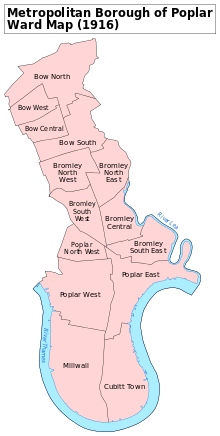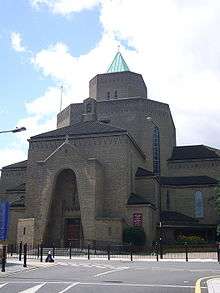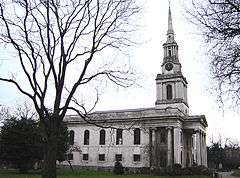Poplar, London
Coordinates: 51°30′24″N 0°01′04″W / 51.5066°N 0.0178°W
Poplar is a historical, mainly residential area of East London, England, in the London Borough of Tower Hamlets. It is about 5.5 miles (8.9 km) east of Charing Cross. Historically a hamlet in the parish of Stepney, Middlesex, in 1817 Poplar became a civil parish.
In 1855 the Poplar District of the Metropolis was formed, which also included Bromley and Bow. The district became the Metropolitan Borough of Poplar in 1900 which was abolished in 1965. The district centre is Chrisp Street Market. Poplar contains notable examples of public housing including the Lansbury Estate and Balfron Tower.
Area's profile
Architecturally it is a mixture of 18th and 19th-century terraced houses and 20th-century council estates.
History


St Matthias Old Church is located on Poplar High Street, opposite Tower Hamlets College. It is next to Poplar Town Hall – which has mosaic detail – and Poplar Bowls Club, which is part of Poplar Recreation Ground. A recently reopened sports centre called The Workhouse stands on the site of Poplar Workhouse, where local politician Will Crooks spent some of his earliest years (a nearby council housing estate is named after him).
The Metropolitan Borough of Poplar was the location, in 1921, of the Poplar Rates Rebellion, led by the Mayor, George Lansbury, who was later elected as leader of the Labour Party. As part of the 1951 Festival of Britain, a new council housing estate was built to the north of the East India Dock Road and named the Lansbury Estate after him. This estate includes Chrisp Street Market, which was greatly commended by Lewis Mumford. The same era also saw the construction of the Robin Hood Gardens housing complex (overlooking the northern portal of the Blackwall Tunnel) – designed by architects Peter and Alison Smithson – and the similarly brutalist Balfron Tower, Carradale House and Glenkerry House (to the north) – designed by Ernő Goldfinger. Other notable buildings in Poplar include Poplar Baths, which reopened in 2016 having finally closed in 1988, after the efforts of local campaigners.
During the development of the Isle of Dogs the street signs pointed to the new development (by the LDDC), and Poplar was lost for a decade or more.
In 1998, following ballots of the residents, Tower Hamlets Council transferred parts of the Lansbury estate and six other Council housing estates within Poplar to Poplar HARCA, a new housing association set up for the purpose of regenerating the area. The following year, tenants on further estates voted to remain with the Council. However, after a lengthy consultation of all Council estates in Tower Hamlets begun in 2002, most estates in Poplar did transfer to Poplar HARCA, East End Homes and other landlords between 2005 and 2007.
Wartime bombings
Although many people associate wartime bombing with The Blitz during World War II, the first airborne terror campaign in Britain took place during the First World War. Air raids in World War One caused significant damage and took many lives. German raids on Britain, for example, caused 1,413 deaths and 3,409 injuries. Air raids provided an unprecedented means of striking at resources vital to an enemy's war effort. Many of the novel features of the war in the air between 1914 and 1918—the lighting restrictions and blackouts, the air raid warnings and the improvised shelters—became central aspects of the Second World War less than 30 years later.
The East End of London was one of the most heavily targeted places. Poplar, in particular, was struck badly by some of the air raids during the First World War. Initially these were at night by Zeppelins which bombed the area indiscriminately, leading to the death of innocent civilians.
The first daylight bombing attack on London by a fixed-wing aircraft took place on 13 June 1917. Fourteen German Gotha G bombers led by Hauptmann Ernst Brandenberg flew over Essex and began dropping their bombs. It was a hot day and the sky was hazy; nevertheless, onlookers in London's East End were able to see 'a dozen or so big aeroplanes scintillating like so many huge silver dragonflies'. These three-seater bombers were carrying shrapnel bombs which were dropped just before noon. Numerous bombs fell in rapid succession in various districts. In the East End alone 104 people were killed, 154 seriously injured and 269 slightly injured.
The gravest incident that day was a direct hit on a primary school in Poplar. In the Upper North Street School at the time were a girls' class on the top floor, a boys' class on the middle floor and an infant class of about 50 pupils on the ground floor. The bomb fell through the roof into the girls' class; it then proceeded to fall through the boys' classroom before finally exploding in the infant class. Eighteen pupils were killed, of whom sixteen were aged from 4 to 6 years old. The tragedy shocked the British public at the time.[1]
Notable residents
- Teddy Baldock, "The Pride of Poplar", Commonwealth Boxing Bantamweight Champion 1928–30[2]
- Neil Banfield, coach at Arsenal F.C.
- Will Crooks MP, social reformer and first Labour Mayor in London; the Will Crooks estate on Poplar High Street is named after him
- Tommy Flowers, designer of the first programmable electronic computer
- Angela Lansbury, Hollywood actress and granddaughter of George Lansbury (she, however, maintains she was born in the Regent's Park area)
- Sir Nicholas de Loveyne held the manor of Poplar and made his will there in 1375 four days before he died.
- John McDougall, politician, represented Poplar from 1889 to 1913. A small park near Millwall Dock is named after him.
- John Mucknell, "The King's Pirate" (born 1608, lived in Poplar after he married)[3]
- Harry Redknapp, football manager, formerly of Bournemouth, West Ham United, Southampton, Portsmouth, Tottenham Hotspur and Queens Park Rangers football clubs. Father of Jamie Redknapp, the former Liverpool captain
- Richard Spratly, discoverer of the Spratly Islands in 1843.
- H. M. Tomlinson, travel-writer, journalist, and author of The Sea and the Jungle (1912)
- Jennifer Worth, Call the Midwife author
In art, entertainment, and media
Balfron Tower has been featured in various other music videos, films and television programmes, as have various other locations in Poplar. According to movie website IMDb, locations around Poplar have been used in the following feature films:
- 1984 (1956)
- To Sir, With Love (1967)
- A Fish Called Wanda (1988)
- The World Is Not Enough (1999)
- The Da Vinci Code (2003)
- 28 Weeks Later (2007; Woodstock Terrace and Balfron Tower)
Film
- The documentary film Fly a Flag for Poplar (1974) features Poplar and the people who live there, seen in their day-to-day lives and organising their own local festivals. Poplar today is looked at in the light of the past, the importance of the labour movement in the beginning of the century, highlighted by the great strikes and events of 1921 when the Poplar Council went to prison.[4]
- Madonna shot scenes in Poplar Baths for the film Shanghai Surprise (1986).
- A documentary film about Chrisp Street Market, E14: A Dying Trade, was filmed in 2011.[5]
Television
- The BBC One television series, Call the Midwife, is set in Poplar in the 1950s.
Notable buildings and structures

A new Church Green[6] was created in 2012 on the site of the former Blitz-bombed Catholic church, across the road from the current church designed by Adrian Gilbert Scott. It is open to the public during the day and public sculptures include:
- The former Catholic Boys' School entrance statue dedicated to dockers and seafarers
- A 15-foot crucifix that stood on the site of the old high altar
- A contemporary granite and light sculpture, A Doorway of Hope, by sculptor Nicolas Moreton
- St Matthias Old Church
Education
Transport
 |
Dalston Shoreditch |
Hackney Mile End |
Stratford Bow |
 |
| Brick Lane Aldgate Stepney |
|
(River Lea) Three Mills | ||
| ||||
| | ||||
| Limehouse Tower Gateway Bank |
Isle of Dogs Canary Wharf Greenwich |
(River Lea) Canning Town |
The nearest Docklands Light Railway stations are All Saints, Blackwall, East India, Langdon Park, Poplar and West India Quay.
The nearest tube station is Canary Wharf.
References
- ↑ Air Commodore Lionel Charlton, "The Air Defence of Britain", Penguin Books, London, October 1938
- ↑ "Teddy Baldock, 'The Pride of Poplar'".
- ↑ Stevens, Todd. The Pirate John Mucknell. p. 18.
- ↑ "Fly a Flag for Poplar". Time Out. 1974. Retrieved September 30, 2011.
- ↑ E14: A Dying Trade at the Internet Movie Database
- ↑ "Two dreams coming true" (PDF). Josephites-CJ. CJ 2012-31
External links
| Wikimedia Commons has media related to Poplar. |
- Poplar photographs in the Local History Library


